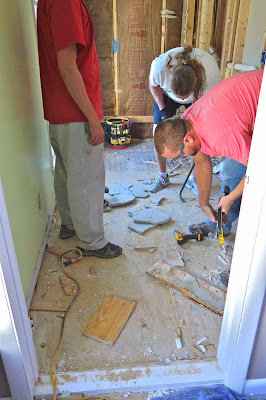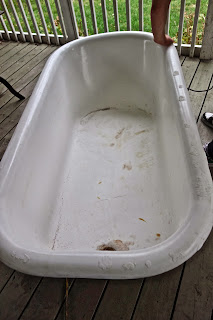We decided to repurpose an older buffet for use as a
vanity in the bathroom remodel. We chose this route for a few reasons - we like 'handmade' stuff, we wanted to save money,
and we thought the style would match the farmhouse well.
After weeks (months?) of craigslist browsing,
we finally found the perfect buffet. Sadly it wasn't as
cheap as a lot of craigslist finds (350, +25 for them to deliver), but I thought it was worth the investment.
I really wanted a piece with center doors to maximize the storage we could get since we ripped a closet out of the bathroom to fit a double vanity. Converting dressers with drawers in the middle requires cutting through several drawers to accommodate the sink drain piping and that kills a lot of your potential storage.
I really loved the buffet feet (which remind me of the
clawfoot tub feet) and the woodwork along the base. Because of the bowed front of the buffet, we've opted to use a single extra large (27" wide) oval sink, which mirrors the curve well.
Originally it would have been nice to have his and her
sinks - but it just wasn't right for this buffet. And let's
be honest, I doubt anyone had double sinks in 1911, right?
At the end of the day, a single extra large sink is more
era-appropriate and farmhouse-appropriate. :)
Though I'm not sure exactly what era this buffet is from
(I highly doubt it's from the early 1900's), I am confident that it will match our bathroom perfectly!
* * * * *
The Refinishing Work
We knew we wanted to paint the buffet and stick
with our black and white theme, but we weren't sure how
much black and how much white to do. After looking at several (dozens!) of b&w painted dressers on pinterest, Clint decided
that he preferred the 'less is more' look.
We decided to paint the entire buffet white except for the top and the hardware. We thought it might be weird to have a white sink on top of a white vanity (and the whites might not match perfectly), so a black top seemed like the perfect solution.
The first step in prepping the buffet was sanding
it and repairing the wood where needed. We sanded with 100
grit sandpaper. We probably *should* have gone over it again with finer grit sandpaper to make sure it was really smooth... but we're lazy... and uh, this would make the buffet
look more 'antiqued' or 'rustic'... maybe? :)
There were some chips in the top that needed filling,
and one part of the woodwork on the base needed repair.
We used Elmer's Carpenter Wood Filler.
and one part of the woodwork on the base needed repair.
We used Elmer's Carpenter Wood Filler.
After letting the primer fully dry, we applied
the actual white paint to the dresser. For the exterior
coat, we used Rustoleum Stops Rust Satin White Spray Paint.
We did several light coats. I think we used about 4 cans
for full coverage of the dresser and drawers.
After the white dried, I began painting
the buffet top - but I haven't finished yet.
I've been having some difficulties with the black
paint we chose for the top, and its been
nothing short of a huge pain! :(
Once I get that last coat finished, I'll seal the whole
piece using polyurethane on the top, and polyacrylic on the
body of buffet. I've read that polyurethane is a better seal
against water (which is important for the top where the
sink will be), but yellows over time - which is why
we'll seal the white areas with polyacrylic
which isn't supposed to yellow.
I can't wait till it's finished - and to post an update
of the completed buffet vanity!
Stay tuned :)
Check out the final product in Part 2 here!






















